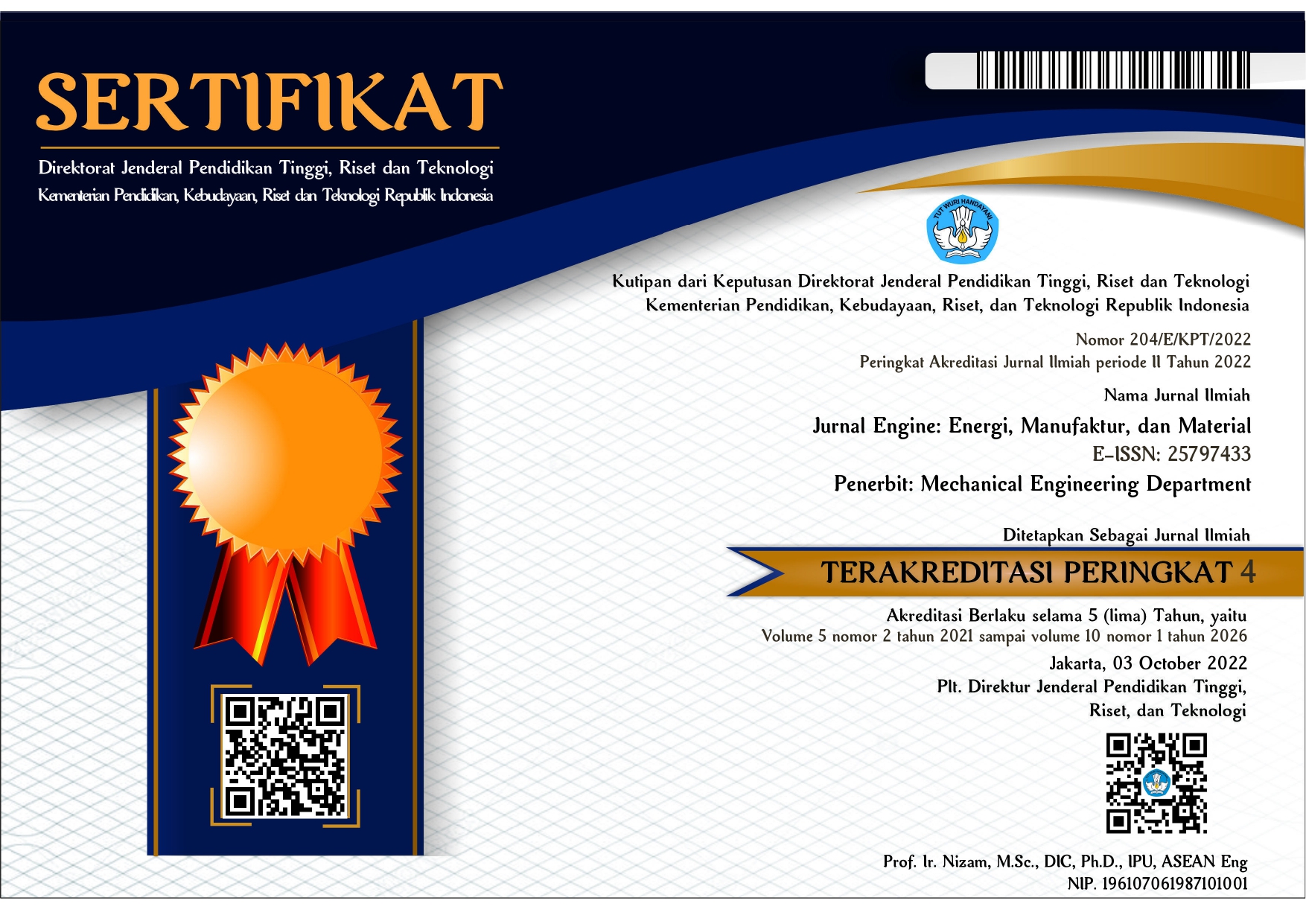Analisa Pengaruh Variasi Komposisi Bahan Limbah dari Serat Kelapa Muda, Batang Pisang dan Kertas Bekas terhadap Kekuatan Bending Sebagai Papan Komposit
DOI:
https://doi.org/10.30588/jeemm.v1i2.259Keywords:
young coconut fiber, banana stem, waste paper, composite, bendingAbstract
The composite is a combination of two or more materials to produce a new material with unique properties compared to the nature of the base material prior to mixing and surface bonding occurs between each constituent material. The purpose of this research is to know the influence of waste material composition from plant fiber, that is young coconut fiber, banana stem, and calendar waste paper to bending strength on composite board by using Epoxy resin wood type. The process of printing the composite board is done in the Laboratory of Integrated Mechanical Engineering University Proklamasi 45 Yogyakarta. The three raw materials that have been crushed and dried, mixed with the breaking time of each 5" and 10" with their respective ingredients composition, namely Young Coconut Fiber: Banana Stem Fiber: Calendar Waste Paper =25:25:50; 25:50:25; 50:25:25 (%). Each treatment was repeated 3 times. Observation was done by calculating raw material composition and time of destruction process against bending strength of composite board which resulted very significant effect on water content, fracture, and flexibility of composite board. Bending strength testing is performed using a robust Universal Testing Machine (UTM). The result of this research produced the most optimum material composition of bending strength into composite board, ie composition III with the duration of destruction for 5", that is the average MoE value of 17.069,76 kg/cm² and the average value of MoR is 83,78 kg/cm². From this research is expected to get new engineering technique from agriculture waste become composite board with economic value.
References
Amin, M., & Samsudi, R. (2010). Pemanfaatan Limbah Serat Sabut Kelapa Sebagai Bahan Pembuat Helm Pengendara Kendaraan Roda Dua. Prosiding Seminar Nasional Unimus. ISBN: 978.979.704.883.9
Frick, H., & Koesmartadi, C. (2012). Ilmu Bahan Bangunan (Cetakan ke-10). Penerbit Kanisius, ISBN 978-979-672-444-4
Saleh, A., Pakpahan, M. M., & Angelina, N. (2009). Pengaruh Konsentrasi Pelarut, Temperatur dan Waktu Pemasakan Pada Pembuatan Pulp dari Sabut Kelapa Muda, No.3. Jurnal Teknik Kimia, Vol.16
Sari, N. H., Sinarep, Taufan, A., & Yudhyadi, I. (2011). Ketahanan Bending Komposit Hybrid Serat Batang Kelapa/Serat Gelas Dengan Matrik Urea Formaldehyde. Jurnal Energi dan Manufaktur, Vol. 5 (1), hal. 91-97.
Soekardi, Y. (2012). Pemanfaatan & Pengolahan Kelapa. Yrama Widya, ISBN: 978-979-077-427-8
Sucipto, C. D. (2012). Teknologi Pengolahan Daur Ulang Sampah. Gosyen Publishing
Sudarsono, Rusianto, T., & Suryadi, Y. (2010). Pembuatan Papan Partikel Berbahan Baku Sabut Kelapa dengan Bahan Pengikat Alami (Lem Kopal). Jurnal Teknologi, Vol. 3(1), hal. 22-32.
Downloads
Published
How to Cite
Issue
Section
License
Authors who publish with Jurnal Engine: Energi, Manufaktur, dan Material agree to the following terms:
Authors retain copyright and grant the Jurnal Engine: Energi, Manufaktur, dan Material right of first publication with the work simultaneously licensed under a Creative Commons Attribution 4.0 International License that allows others to share (copy and redistribute the material in any medium or format) and adapt (remix, transform, and build upon the material) the work for any purpose, even commercially with an acknowledgment of the work's authorship and initial publication in Jurnal Engine: Energi, Manufaktur, dan Material. Authors are able to enter into separate, additional contractual arrangements for the non-exclusive distribution of the journal's published version of the work (e.g., post it to an institutional repository or publish it in a book), with an acknowledgment of its initial publication in Jurnal Engine: Energi, Manufaktur, dan Material. Authors are permitted and encouraged to post their work online (e.g., in institutional repositories or on their website) prior to and during the submission process, as it can lead to productive exchanges, as well as earlier and greater citation of published work (See The Effect of Open Access).


















